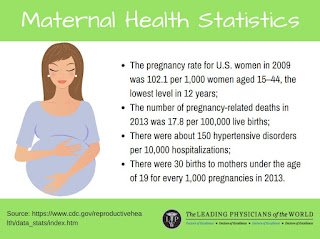Maternal Health and child
Improving
maternal health is critical to saving the lives of hundreds of thousands of
women who die due to complication from pregnancy and childbirth each year. Over
90 percent of these deaths could be prevented if women in developing regions
had access to sufficient diets, basic literacy and health services, and safe
water and sanitation facilities during pregnancy and childbirth.
Goal #1: Maternal survival
Maternaldeath has dropped significantly since the adoption of the MDGs. The universal
maternal mortality ratio has reduced by 45 percent between 1990 and 2013, from
380 to 210 maternal deaths per 100,000 live births.
Despite the
progress, every day lots of women die during pregnancy or from complications
arising from childbirth. The maternal mortality rate in developing regions is
around 14 percent higher than in developed nations. Universally, there were an
estimated 289,000 maternal deaths in 2013, which is equivalent to around 800
women dying daily. The highest rate of maternal deaths is in sub-Saharan Africa
and Southern Asia, which collectively accounted for 86 percent of global
maternal deaths.
Most of
these deaths are preventable, with hemorrhage accounting for over 27 percent of
maternal deaths in developing regions and about 16 percent in the developed
regions. Other complications leading to death include high blood pressure
during pregnancy, infections, unsafe abortion, and complications from delivery.
Proven
health-care interventions can help manage or prevent these complications,
including skilled care during childbirth, antenatal care in pregnancy, and care
and support in the weeks following childbirth.
Goal #2: Universal Access to reproductive health
The WHO
recommends four or more antenatal care visits during pregnancy to ensure the
wellbeing of mothers and newborns. During these visits, women should be given
nutritional advice, alerted to warning signs indicating possible problems
during their term, and given support when planning a safe delivery.
Progress
has been slow since 1990, with an average of 52 percent of pregnant women in
developing regions receiving the recommended number of antenatal care visits in
2014, a 17 percent increase in 25 years. Coverage levels in sub-Saharan Africa
have remained still for the past two decades, with slight improvement in the
number of women receiving the recommended care: 47 to 49 percent.
Use of contraceptives
Universally,
the number of women aged 15 – 49 in marriage or a union, who were using
contraceptives (as a way to reduce the incidence of unintended pregnancies,
maternal deaths, and unsafe abortions) has increased from 55 to 64 percent
between 1990 and 2015. The proportion in sub-Saharan Africa has more than
doubled, from 13 to 28 percent, while that in Southern Asia increased from 39
to 59 percent in the same 25 years.
Nine in
every 10 contraceptive users were using effective methods, including condoms,
injectables, intrauterine devices, female and male sterilisation, oral hormonal
pills, or an implant.
Early childbearing
Adolescent
childbearing is not only harmful to the health of both the girls and child they
bear, but also reflects the broader forms of social and economic
marginalisation of girls. Certain measures have been taken to delay
childbearing and prevent unintended pregnancies among this vulnerable age
group, including increasing their opportunities for education and eventual paid
employment. As a result, the birth rate among adolescent girls aged 15 – 19 has
reduced from 59 births per 1,000 girls to 51 births between 1990 and 2015.
One of the most fundamental ways to reduce maternal morbidity and mortality is ensuring that every birth occurs with the help of skilled health personnel – midwife, nurse, or doctor. Significant progress has been made in reducing maternal deaths and increasing global access to reproductive health, though the targets were not achieved. Improvements can be made by addressing the large inequities in maternal health, and strengthening individual country capacity to tackle the problems.





Comments
Post a Comment